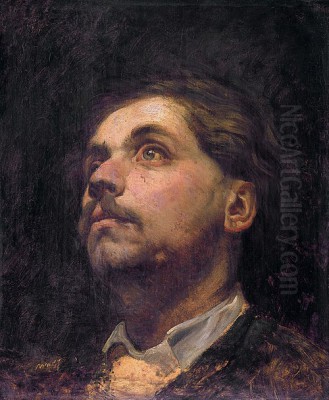
Jacob Henricus Maris stands as one of the most significant figures in 19th-century Dutch art. A leading member of the influential Hague School, Maris dedicated his career to capturing the unique atmosphere and subtle beauty of the Dutch landscape. His work, characterized by its evocative portrayal of light, water, and sky, earned him widespread acclaim during his lifetime and secured his place as a master of landscape painting. His contributions went beyond his own canvases, shaping the direction of Dutch art in the latter half of the century.
Born in The Hague on August 25, 1837, Jacob was the eldest of three brothers who would all achieve artistic renown. His younger siblings, Matthijs Maris and Willem Maris, also became prominent painters associated with the Hague School. This familial connection fostered a supportive, albeit sometimes competitive, artistic environment from an early age. Their shared passion for art was evident early on, setting the stage for their collective impact on the Dutch art scene.
Early Life and Artistic Formation
Jacob Maris's formal artistic training began at the Royal Academy of Art in The Hague. Seeking further instruction, he later entered the studio of Hubertus van Hove, a painter known for his interiors and cityscapes. This period provided Maris with foundational skills in drawing and painting, exposing him to the technical aspects of the craft and the prevailing artistic conventions of the time. Van Hove's influence can be discerned in some of Maris's earlier, more detailed works.
Around 1855, Jacob moved to Antwerp with his brother Matthijs. They rented a space together, supporting themselves by undertaking commercial work, notably copying portraits of the royal family. This period of collaboration was crucial for their development, allowing them to hone their skills while navigating the practicalities of an artistic career. The experience of working side-by-side undoubtedly fostered mutual influence and artistic dialogue between the brothers during these formative years.
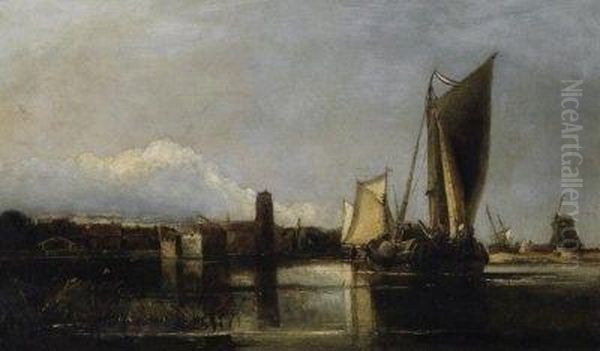
Their time in Antwerp was followed by travels that broadened their horizons. The Maris brothers journeyed through Germany, visiting cities like Cologne and Mannheim, before continuing to Switzerland and eventually France, reaching Paris. These travels exposed them to different landscapes, artistic traditions, and contemporary art movements, enriching their visual vocabulary and potentially influencing their later stylistic choices. Exposure to international art scenes was vital for artists seeking to innovate beyond purely local traditions.
Upon returning to the Netherlands around 1865, after a period spent working in Paris, Jacob Maris settled back in The Hague. This marked a pivotal moment in his career. He began to fully develop the style that would define his mature work and solidify his reputation. The familiar Dutch landscapes, with their expansive skies and waterlogged terrain, became his primary source of inspiration. He also spent time working in Oosterbeek, a village known as the Dutch 'Barbizon', associating with other artists drawn to its picturesque scenery.
The Hague School and Maris's Role
Jacob Maris emerged as a central figure, arguably the leader, of the Hague School. This movement, flourishing roughly between 1860 and 1890, represented a shift away from the idealized scenes of Romanticism towards a more realistic and atmospheric depiction of the Dutch landscape and daily life. The Hague School artists sought to capture the specific mood, light, and weather conditions of their surroundings, often working outdoors or using sketches made en plein air.
The group included a constellation of talented painters besides the Maris brothers. Key figures associated with the Hague School include Jozef Israëls, known for his poignant scenes of fishing communities; Anton Mauve, Jacob's cousin-in-law and a master of pastoral landscapes often featuring sheep; Hendrik Willem Mesdag, famous for his seascapes, particularly the monumental Panorama Mesdag; Johannes Bosboom, who specialized in church interiors; and landscape painters like Paul Gabriël, his brother Constant Gabriël, and Willem Roelofs. Gerard Bilders is often seen as a precursor whose work influenced the school's development.
Within this group, Jacob Maris was particularly revered for his powerful interpretations of the Dutch landscape. His approach emphasized tone and atmosphere over meticulous detail, often employing a palette dominated by greys, browns, and silvery hues. He excelled at rendering the vast, cloud-filled skies characteristic of the Netherlands, capturing the interplay of light and shadow on water and land. His leadership was not necessarily formal but stemmed from the strength and influence of his artistic vision.
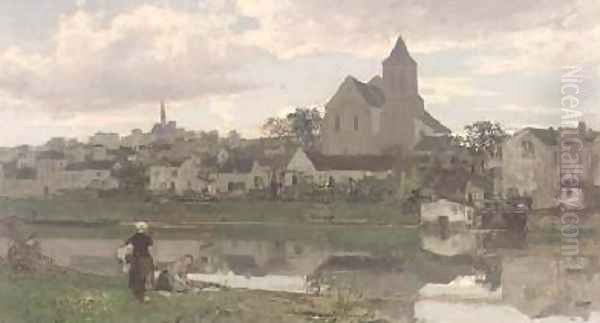
The Hague School artists shared a common interest in depicting the unadorned reality of their environment, finding beauty in the mundane and the everyday. They painted the canals, windmills, polders, beaches, and fishing villages that defined the Dutch landscape. While their styles varied individually, they were united by a commitment to tonal harmony, atmospheric effect, and an honest portrayal of their subject matter, often imbued with a sense of quiet melancholy or serene contemplation. Jacob Maris's work perfectly encapsulated these ideals.
Artistic Style and Technique
Jacob Maris's style is often described as atmospheric realism. While grounded in careful observation of nature, his paintings transcend mere topographical accuracy. He was a master of suggestion, using broad, confident brushstrokes and subtle tonal gradations to evoke mood and feeling. His ability to capture the diffused, silvery light of the Dutch climate led critics to nickname him the "Silvery Maris," although his palette could also incorporate rich browns and earthy tones.
His technique involved building up layers of paint, often allowing underlayers to show through, creating a textured surface that added vibrancy to his work. Unlike the smooth, detailed finish favored by earlier Romantics, Maris embraced a looser, more painterly approach. This technique allowed him to convey the transient effects of light and weather – the dampness in the air, the movement of clouds, the reflections on wet surfaces – with remarkable immediacy.
Water and sky dominate many of Maris's compositions. He possessed an extraordinary ability to depict the complex relationship between these elements. His skies are rarely empty blue expanses; instead, they are dynamic entities filled with rolling clouds, conveying a sense of depth and movement. Reflections in canals, rivers, or rain-slicked streets are rendered with fluid brushwork, capturing the shimmering quality of light on water. This focus on atmosphere became a hallmark of his work.
While primarily a landscape painter, Maris also incorporated figures and architectural elements into his compositions. Figures, such as fishermen, farmers, or women walking along canals, are typically integrated seamlessly into the landscape, often depicted with simplified forms that emphasize their connection to their environment rather than individual portraiture. His cityscapes, particularly views of Amsterdam or Dordrecht, similarly prioritize mood and light over precise architectural rendering, transforming familiar scenes into poetic visions.
Signature Themes and Motifs
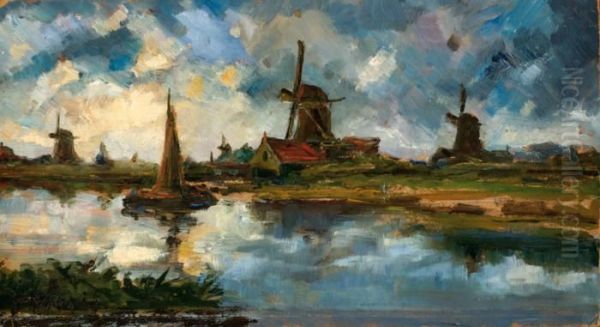
The Dutch landscape provided Maris with an inexhaustible source of inspiration. Canals and rivers feature prominently in his oeuvre, often shown winding through flat polders or reflecting the gabled houses of towns. These waterways were not just picturesque elements but vital parts of Dutch life and commerce, and Maris captured their tranquil yet functional character. Towpaths, barges, and bridges often populate these scenes, adding touches of human activity.
Windmills are another recurring motif strongly associated with Jacob Maris. He painted them in various settings and conditions – standing solitary against dramatic skies, grouped near waterways, or integrated into village scenes. For Maris, as for many Hague School painters, the windmill was a powerful symbol of the Netherlands, representing both its traditional past and its ongoing relationship with the elements, particularly wind and water.
Coastal scenes, especially views of the beach at Scheveningen near The Hague, were also a favourite subject. He depicted fishing boats (known as 'bomschuiten') drawn up on the sand, the vast expanse of the North Sea under changeable skies, and the daily activities of the fishing community. These works often convey the raw beauty and sometimes harsh conditions of coastal life, rendered with his characteristic atmospheric depth.
Maris also produced notable cityscapes. His views of older Dutch towns like Amsterdam and Dordrecht are particularly admired. He often focused on the interplay of light on historic buildings, reflections in canals, and the bustling or quiet moods of urban environments. Works like his depiction of the Schreierstoren in Amsterdam showcase his ability to imbue architectural subjects with the same atmospheric richness found in his pure landscapes, creating evocative urban portraits.
Representative Masterpieces
Several works stand out as quintessential examples of Jacob Maris's artistry. Ship on the Riverbank (also known as At the Water's Edge or On the Water) is celebrated for its masterful handling of light and atmosphere. The painting depicts boats moored along a waterway under a soft, hazy sky, perfectly capturing a sense of stillness and tranquility through subtle tonal harmonies and fluid brushwork. It exemplifies his "silvery" style.
Ship on the Scheveningen Beach is another iconic work, showcasing his skill in depicting coastal scenes. The composition often features fishing boats resting on the wet sand under vast, cloudy skies, with the sea stretching towards the horizon. These paintings capture the unique light and atmosphere of the Dutch coast, blending realism with a powerful sense of place and mood. They remain among his most popular and recognizable works.
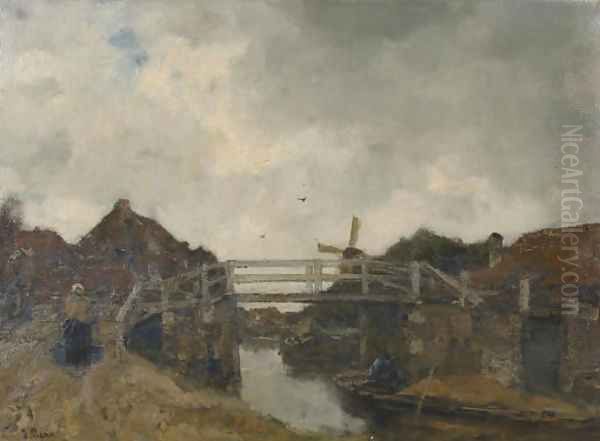
His Cityscape of the Schreierstoren, Amsterdam demonstrates his talent for urban views. The historic tower and surrounding buildings are rendered with attention to their character but enveloped in a characteristic Maris atmosphere, with light reflecting off water and wet surfaces. It's less an architectural study and more a poetic interpretation of the city's mood and history, seen through the lens of light and weather.
View of Montigny-sur-Loing, painted during his time in France, shows his ability to apply his Dutch sensibility to a foreign landscape. Even depicting a French town, the painting retains the atmospheric qualities and tonal palette associated with his Dutch works, often featuring the leaden grey skies typical of his style. It highlights the consistency of his artistic vision regardless of location.
Other notable works include The Mill, which was exhibited internationally, showcasing his fascination with this Dutch icon. The series of Royal Orange Portraits, undertaken with his brother Willem, represents a different facet of his work, demonstrating their skill in portraiture early in their careers. Paintings like Horses and Plowman and Shepherd with his flock beside a river highlight his engagement with rural life, integrating figures naturally into expansive landscapes. Off the Maas is another example capturing the essence of the Dutch river landscape.
Relationships with Contemporaries
Jacob Maris's closest artistic relationships were undoubtedly with his brothers, Willem and Matthijs. They shared studio space, collaborated on projects like the Orange portraits, and provided mutual support and critique, especially in their early careers. While Willem largely remained focused on pastoral landscapes similar in spirit to Jacob's work, Matthijs's path diverged significantly. Influenced by artists like the German Romantic Ludwig Richter and possibly Georg Laves, as well as later Symbolist trends, Matthijs developed a more mystical, dreamlike style distinct from the Hague School's realism.
Beyond his family, Maris was connected to the broader circle of Hague School artists. He interacted with figures like Anton Mauve, Jozef Israëls, and Hendrik Willem Mesdag through shared exhibitions, artistic societies like the Pulchri Studio in The Hague, and informal gatherings. These interactions fostered a sense of community and shared purpose, even as each artist maintained their individual style. The Oosterbeek period also brought him into contact with artists like Frederik Hendrik Kaemmerer, whom Maris depicted painting outdoors, and possibly Emil van der Blom.
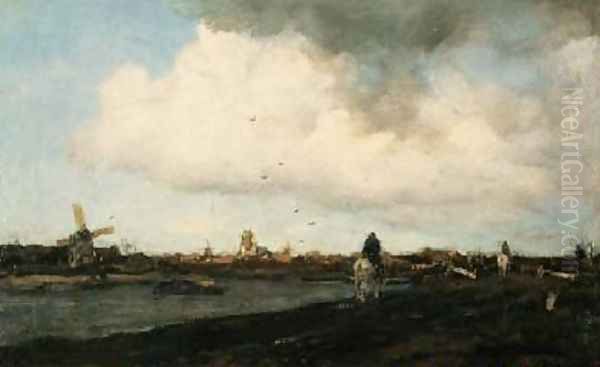
His early training under Hubertus van Hove provided a crucial foundation. While Maris moved beyond Van Hove's style, the initial instruction was formative. The influence of the French Barbizon School (painters like Jean-Baptiste-Camille Corot, Jean-François Millet, and Charles-François Daubigny) on the Hague School in general is well-documented. While direct interaction might be limited, Maris would have been aware of their work and shared their commitment to landscape, atmosphere, and depicting rural life, likely absorbing these influences through exhibitions and discussions within his circle.
Maris's stature meant he was also a figure younger artists looked up to. His success and distinctive style made him influential, setting a standard for landscape painting in the Netherlands during his time. His interactions were thus multifaceted: family collaborator, peer within a movement, student, and respected master.
Later Years and Legacy
By the later decades of the 19th century, Jacob Maris was widely recognized as one of the foremost painters in the Netherlands. His work was sought after by collectors both domestically and internationally, particularly in Great Britain, Canada, and the United States. He exhibited frequently, including at major international shows like the Berlin International Art Exhibition, further cementing his reputation abroad. His paintings commanded high prices, reflecting his status in the art market.
His dedication to capturing the essence of the Dutch landscape never wavered. He continued to produce powerful and evocative paintings until the end of his life. His work maintained a remarkable consistency in quality and vision, refining rather than radically changing his signature atmospheric style. He remained committed to the principles of the Hague School, even as newer art movements began to emerge.
Jacob Henricus Maris passed away on August 7, 1899, while visiting the spa town of Karlsbad (now Karlovy Vary in the Czech Republic). His death marked the end of an era for the Hague School, of which he had been such a dominant force. His legacy, however, endured. His paintings continue to be admired for their technical mastery, emotional depth, and profound connection to the Dutch landscape.
Today, Jacob Maris's works are held in major museum collections around the world, including the Rijksmuseum in Amsterdam, the Kunstmuseum Den Haag, the National Gallery in London, the Metropolitan Museum of Art in New York (associated with the Ford Art Museum collection mentioned in source), the Clark Art Institute, and the Krannert Art Museum, among many others. His influence can be seen in subsequent generations of Dutch landscape painters. No specific mysteries or widely circulated anecdotes surround his life; his reputation rests firmly on his significant artistic achievements.
Conclusion
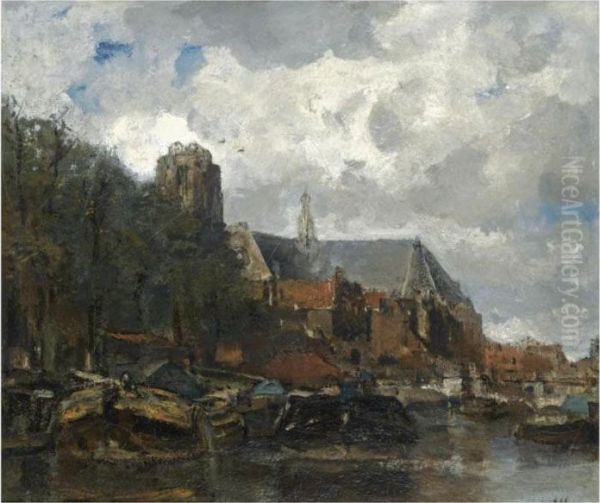
Jacob Henricus Maris remains a towering figure in Dutch art history. As a leading member of the Hague School, he played a crucial role in redefining landscape painting in the Netherlands during the late 19th century. His unique ability to capture the subtle moods, light, and atmosphere of his native land resulted in a body of work that is both deeply personal and universally resonant. Through his evocative depictions of canals, windmills, beaches, and cities, Maris created an enduring vision of the Netherlands, securing his legacy as a master of atmospheric realism and one of his country's most beloved painters.